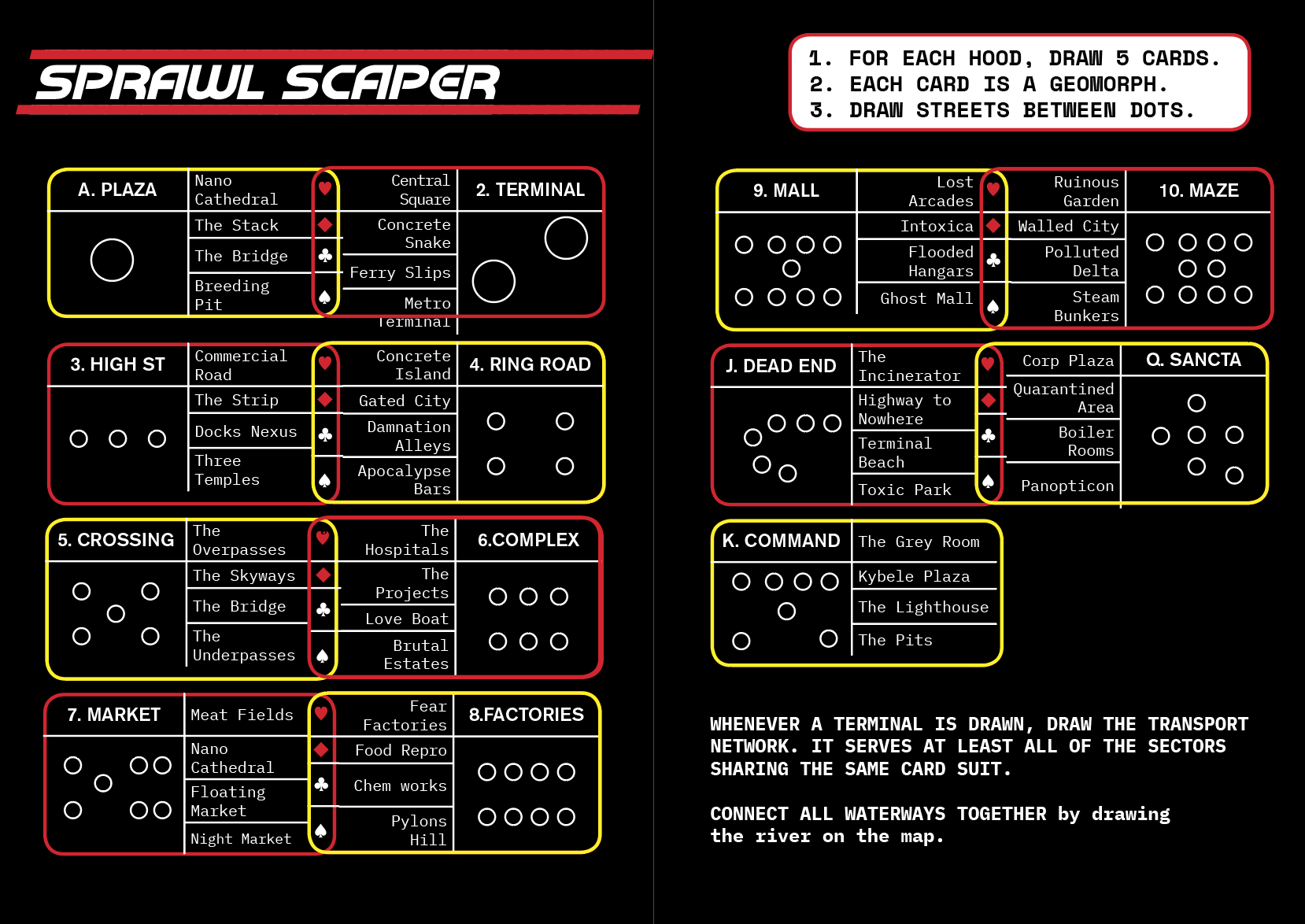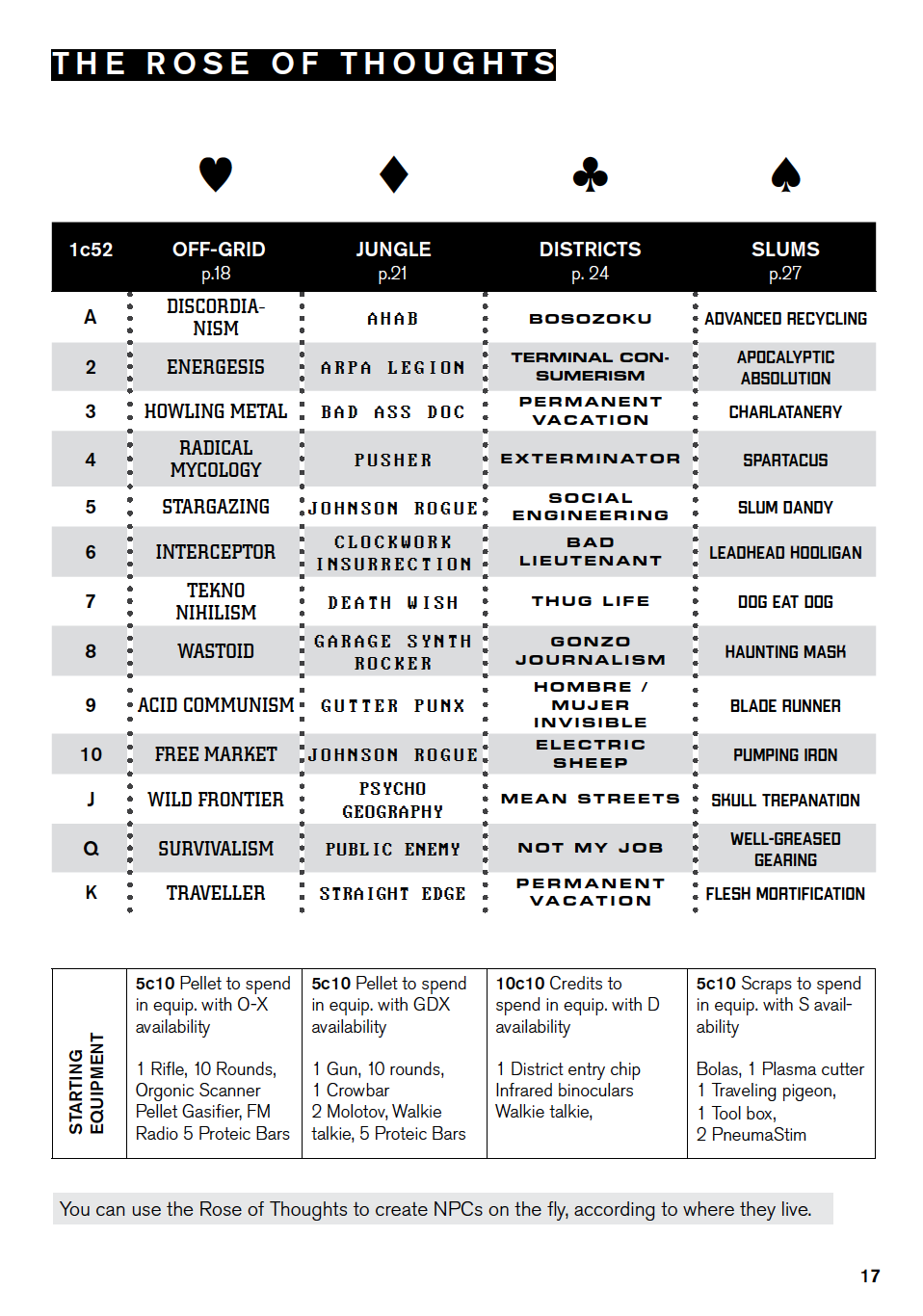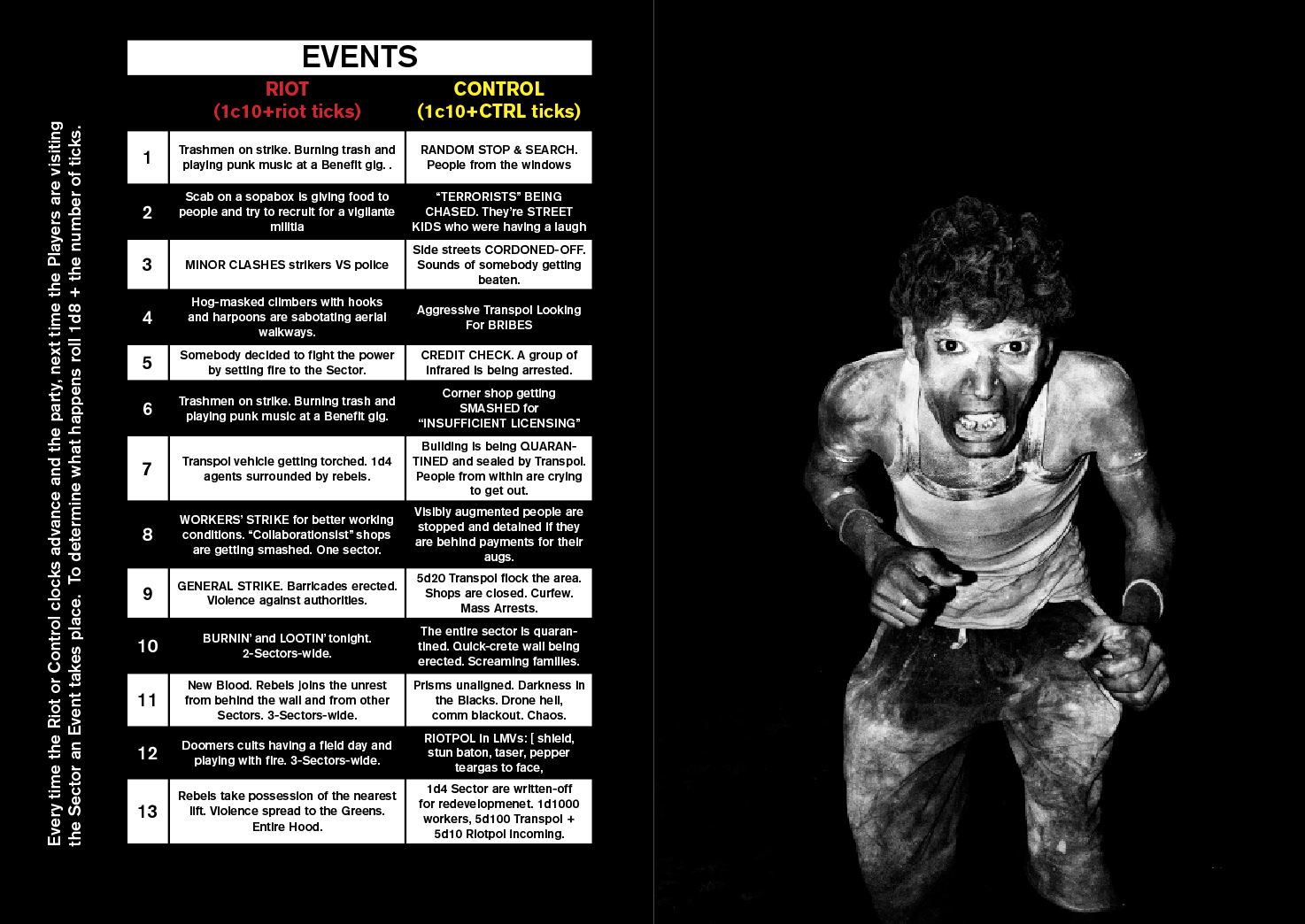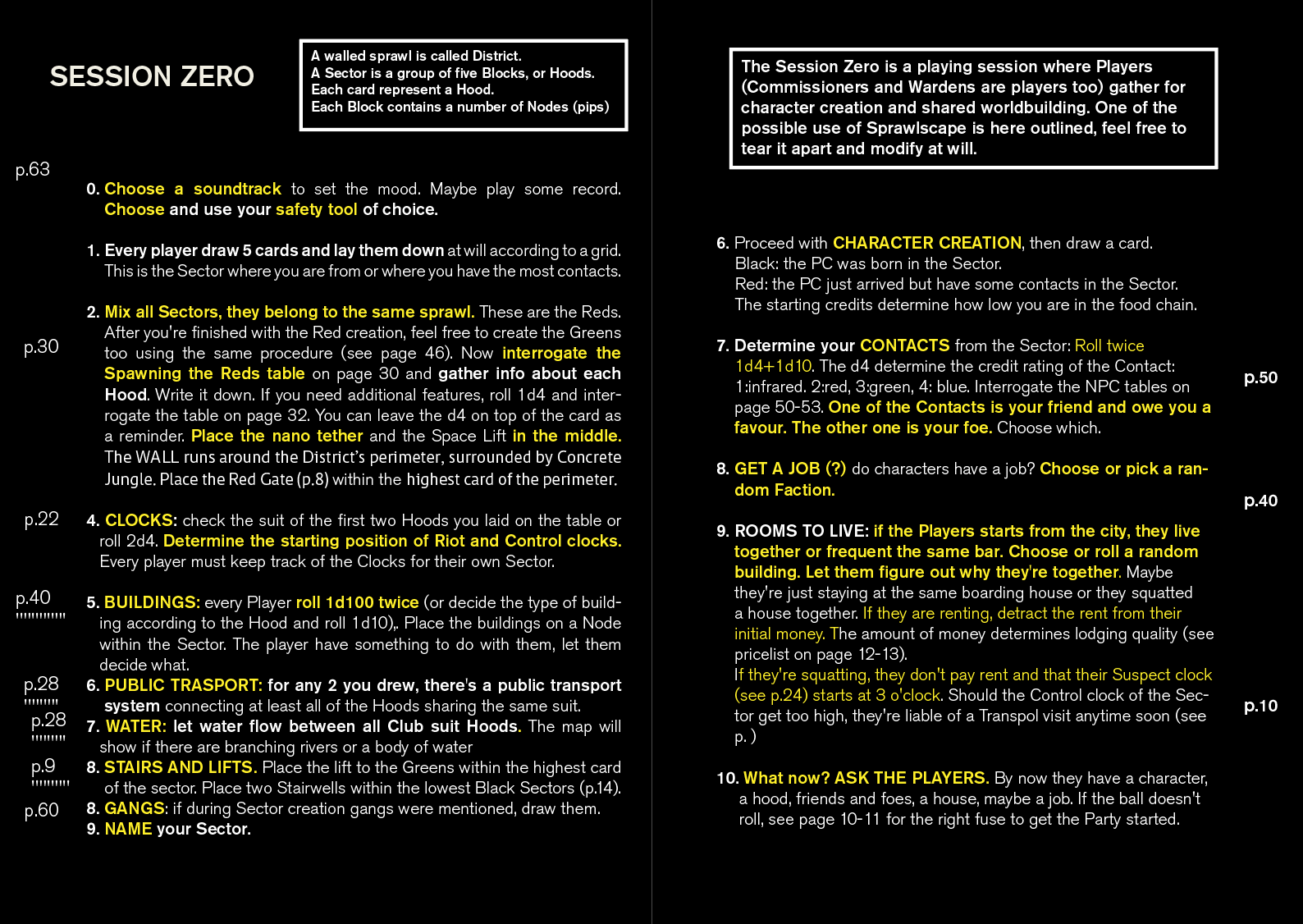
Sprawlscape as a machine. Extended designer notes.
Sprawlscape is a machine.
It’s a different way to do world building.
It’s engine, samples, effects. Music production workflow.
It’s the RPG equivalent of a drum machine, synthesizer and step sequencer all-in-one.
It all starts with a matrix. An empty table and your favourite card deck (I use a Killer Bees deck in the picture)
A single table with 52 entries, encoding a deck of standard cards.
Each card correspond to a Sector, which description is found in the manual (or the flipside of the Megadeck).
The value of a card correspond to a urban environment:plaza, high street, market, maze, fortress, dead end…
The pips can be visualised as interconnected notable location, each card can be used for geomorph inspiration.
Suits encode transport mode and waterlines (all Clubs are waterways, all spades are connected by Metro etc).
Each District have a 1d4 table for additional Features to give additional character.
There’s a main calculator: the Sprawlscaper.
There’s a set of databases which can interact with each other: buildings, NPCs, events, factions, price catalogue.There’s an optional set of clocks to set the city in motion: Riot, Control, Suspect.

WORLDBUILDING WITH A DECK OF CARDS
Switching from dice to cards for worldbuilding allowed me to find a more organic way to create an environment.
Cards are naturally disposed in grids, which is perfect for urban territory.
Cards can be encoded with information way better than dice: there’s a colour, a suit, a number, faces, etc.

The world at a glance. 13 rows and 4 columns offer the whole range of possibilities.
The C52 table is an organism. <c stands for card like d stands for die>
I built two C54 tables: the SprawlScaper and the Rose of Thoughts for Network 23. They are both powerful world-building engines and useful tools to facilitate improvisation.

The Rose of Thoughts, the noosphere of Network 23. A c52 table.
52 options constitute an ecology and offer a very good range of ideas. The 52 entries communicate with each other. Writing a c52 table shapes the content: It forces to create a coherent ecology instead of disconnected elements and tables. It’s an excellent case for worlds.
You will mix few options at once, but the table hints to a much larger world of possibilities.
Here’s the specs
ENGINES (sampler)
SPRAWLSCAPER C52x4 table
POSHSCAPER C52 table
OSCILLATORS & dynamic effects: CLOCKS
- 3 Clocks: Riot, Control, Suspect
- 1 Gang generator (7 cards: one gang)
- 3 soundtracks: Tekno-noir, Industrial noise, Synthwave.
ALGORITHM (sequencer)
- Session 0: shared worldbuilding and character creation.
- Gentrification mechanic
OPTIONAL PHYSICAL INTERFACE
The MEGADECK. No latency. Quick access to information. No page flipping unless you want to add granularity.
Better flip cards than to flip through manual.
DATABASE (samples):
- 52 Sector description.
- 100 Suburb Buildings and establishments.
- 100 Posh Buildings and establishments.
- 40 NPCs (split into 4 credit levels) can be Friends or Foes.
- 13 Building-related Events.
- 26 Riot and Control Events.
- 52 additional sector features.
- 10 Hood Moods 10 architecture styles.
- 6 Employers/Factions.
additional DB:
Mothership: patches, price list, scum (0e), APOF cybermods and orbital station creations.
Network 23: Rose of Thoughts, items list, vehicles.
COMPATIBILITY MAXER:
- Price aligned with Mothership economy.
- The Star Lift and Point Disappointment orbital station.
- System agnostic.
THE MAP IS NOT THE TERRITORY
The map of the city is always common knowledge. The clocks are Player facing. The Players know what’s going on in the whole city. More or less.
There’s always an element of indeterminacy: each time the Players move to a new Sector, you can roll 1d4 to interrogate the table of additional Sector features.

With the MegaDeck, you can add the additional feature depending upon which side the Players enter the Sector. The maps are collected also in the Kybele Directory PDF, a digital version of the deck of cards with the same exact functionalities). While you’re not looking at them, the Sectors evolve. The Night Market was thriving last time you visited, now it’s eerily desert…
what happened?

FuckinG THINGS up makes good content
Players action have consequences. Players’ actions influence the three Players’ facing Clocks.
Feel free to disregard the Clocks for one-shot sessions, and whenever they’re not needed.
In front of a situation with chaotic potential, the crew can decide to:
Defuse: negative feedback, keep things like they were before. Contain the problem. Keep the clocks down
Accelerate: positive feedback, give a push to the things moving forward.

Every time the Players do some big boom, not only Riot and Control clocks can be affected, a Riot or Control event gets triggered, also the Suspect Clock goes up.
The Suspect Clock going up means attracting unwanted authority attentions and soon also the crew’s Contacts might get in trouble too. Sometimes is better to change Sector, find a new HQ and keep a low profile.
So basically: the crew has a good plan >>>> crew goes Lee Roy Jenkins >>>> big boom >>>>> CTRL or RioT goes up a notch >>>>> A Riot / Control Event is triggered at Sector/Hood level>>>>>>> Suspect goes up.
Each incendiary ending to an adventure bring more fuel to the fire. The machine is in motion.
CLOCKS’ END GAME: GENTRIFICATION / insurrection
Gentrification is the apex of Control while Insurrection happens when Riot reaches 12 o’clock. When Gentrification happens, 1c4 Sector of the whole Hood are being redeveloped and under construction, until new middle class Sectors replace the Suburbs Sectors.
Insurrections spread to other Hoods, and if it becomes city-wide, it could endanger the Green Sectors. How things are going to change, for good or bad, only your campaign will tell.

SESSION 0 ALGORITHM

Here it is. Step by step procedure to generate the city. No need to read the whole manual first. Follow the steps and get surprised. The Session 0 spread focus on shared world building: Each Player build their own Hood and name it. They have friends and affiliations there.Players keep track of the Clocks, might want to generate gangs or place buildings and NPCs.
The NPC might be friends or foes, from outcast to ultra rich. Each Player starts with 1 friend and one foe, these are possible adventure hooks already: every NPC wants something or have something of interest.
The Character sheet is filled halfway through the process: each Player having already created a Hood. The characters are part of the city. Even if they’re astronauts in search of cheap thrills, they have some connection with a particular Hood.
Then, the Players decide if to rent or to squat. They might want to start with a job with one of the six Employers.
Players starts with rent-related expenses, if they decide to rent. If they want to squat, let them: no rent, +1 Suspect Clock, let them decide the Sector, choose the place from the 1d100 buildings table.

this beauty is by Mateo Correal, SS cover features a variation.
Only 8 days left to go, here’s the campaign
https://www.kickstarter.com/projects/network23/sprawlscape
to be continued… next time we will touch upon the MegaDeck interface.
